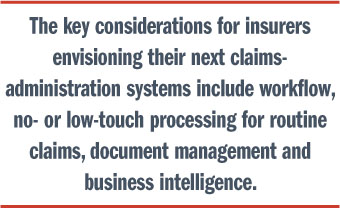It's time to expand both the thinking and action concerning claims—to go beyond the mere transaction.
Accurate and efficient processing of claims has been a critical component of the insurance industry's profit equation since its  inception. Early automation efforts primarily addressed the accounting and reporting aspects of claims operations. As systems have become more sophisticated, the emphasis is now more focused on how the work gets done.
inception. Early automation efforts primarily addressed the accounting and reporting aspects of claims operations. As systems have become more sophisticated, the emphasis is now more focused on how the work gets done.
Streamlining processes and improving efficiencies aim not only at better management of costs. Today, automated systems have the power to transform claims operations by taking business capabilities to the next level: improving the quality of decisions, enhancing the customer experience and integrating claims functions to create an environment for collaboration throughout the organization, as well as with third-party service providers and stakeholders.
Recommended For You
Want to continue reading?
Become a Free PropertyCasualty360 Digital Reader
Your access to unlimited PropertyCasualty360 content isn’t changing.
Once you are an ALM digital member, you’ll receive:
- Breaking insurance news and analysis, on-site and via our newsletters and custom alerts
- Weekly Insurance Speak podcast featuring exclusive interviews with industry leaders
- Educational webcasts, white papers, and ebooks from industry thought leaders
- Critical converage of the employee benefits and financial advisory markets on our other ALM sites, BenefitsPRO and ThinkAdvisor
Already have an account? Sign In Now
© 2025 ALM Global, LLC, All Rights Reserved. Request academic re-use from www.copyright.com. All other uses, submit a request to [email protected]. For more information visit Asset & Logo Licensing.








